The ASUS Zenbook UX305 Review
by Brett Howse on March 25, 2015 8:00 AM ESTBattery Life
Not everyone requires battery life in a laptop. For some, a laptop is something you move from desk to desk, and can keep power close at hand. However even for those types of people (like me) there are going to be times where battery life is much more important, such as on a long trip. We have seen the bar raised considerably in the last several years with respect to battery life.
The ASUS UX305 has the power sipping Core M processor, whose 4.5W TDP means that the CPU/SoC's power consumption is kept quite low. But that is of course only part of the story. The display is a huge driver in energy use, and as we have seen in recent reviews, high resolution displays, although beautiful to look at, can use much more energy than those that sport a lower resolution. Unlike our Dell XPS review, we do not have both the low and high resolution models available for comparison, so for now we will focus on the 1080p model that is available.
To test battery life, we have two workloads. Our light test is light web browsing, and our heavy test increases the number of pages loaded, adds a 1 MB/s file download, and has a movie playing. We set all displays to 200 nits.
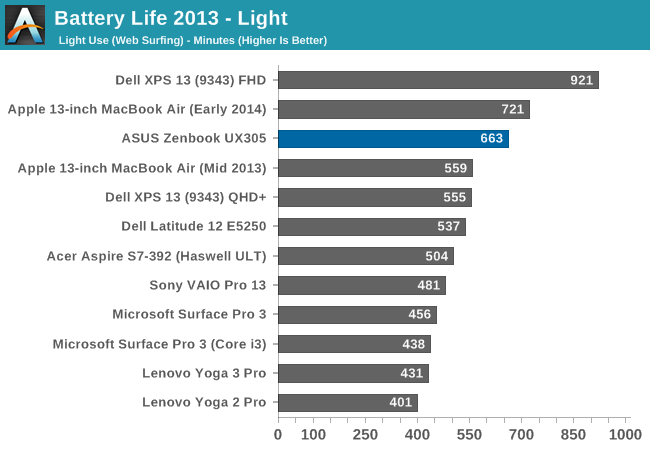
ASUS has packed tremendous battery life into this tiny fanless laptop. At just over 11 hours, it is one of the best results we have seen from any device, and it is all done on just a 45 Wh battery. It is not quite as efficient as the Dell XPS 13, despite the Dell having a 15 watt CPU, but the CPU is just a small part of this test, as it is generally not under much load. To see how the device fares under a heavier load, we will take a look at our Heavy test next.
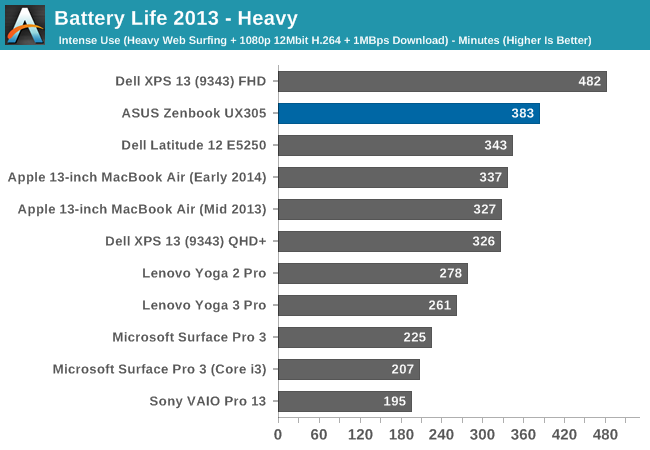
Once again the ASUS performs very well. Despite the thin design, the UX305 has plenty of battery life to handle most workloads with ease. Once more it doesn't quite measure up to the XPS 13, but that device also has a larger battery. To compare all of our devices for energy efficiency with the battery size removed from the equation, we have our normalized graphs.
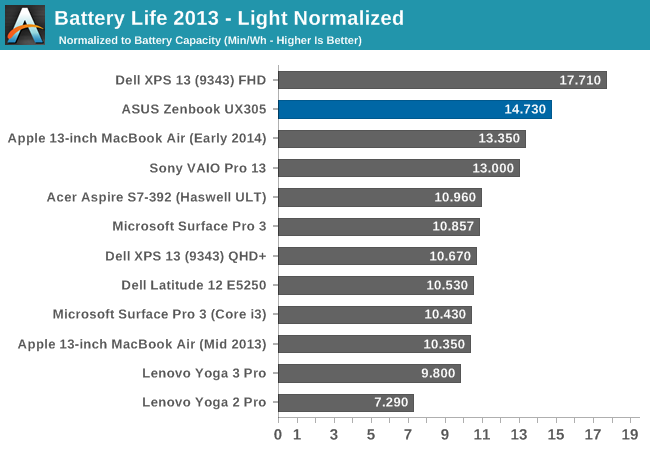
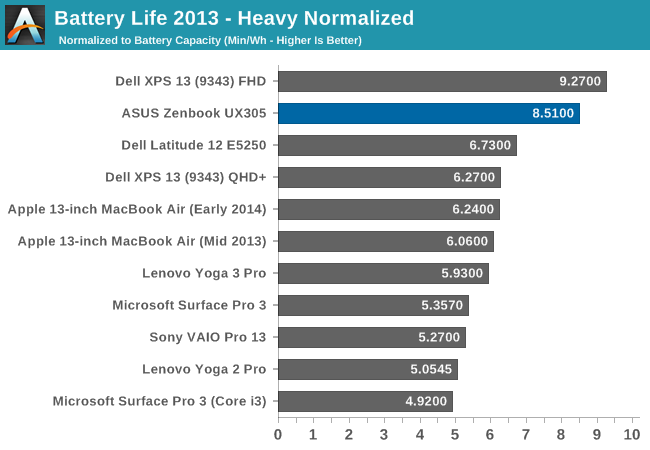
ASUS has done a great job on the overall platform efficiency of the UX305. While not quite class leading, it is quite a bit higher than most devices on the market. With just a 45 Wh battery, the UX305 does an outstanding job.
Charge Time
The other factor in mobility is charge time. Long battery life is great, but if you can top up quickly it can really extend the range of a notebook. The UX305 comes with a 45 watt charger, which seems to be fairly typical these days. There is certainly a trade-off to be made between charging speed and portability, because no one wants to bring a 3 lb charger along with a 2.6 lb notebook.
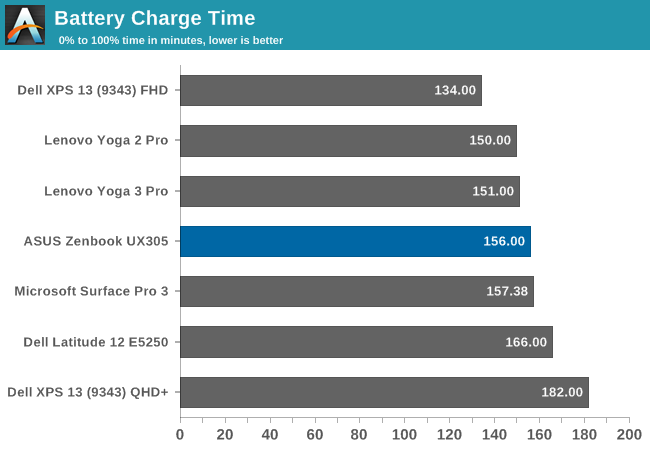
At 156 minutes, the UX305 falls right in line with most devices. Although there is little stopping someone from providing a faster charging rate, it seems most OEMs have settled on at or around this score as a target.
The UX305 charges very consistently, with it only leveling out well after 80% charge.
ASUS would be able to improve these scores with a higher wattage charger, but as compared to its peers it is about the same.
Wi-Fi Performance
ASUS has outfitted the UX305 that we have in for review with the Intel Dual Band Wireless-N 7265 wireless networking chip (not to be confused with the Wireless-AC 7265), which also includes Bluetooth 4.0 support. The change from the 7260 adapter seen predominately last year is a drop in power consumption. With a 2x2:2 design, the 7265 can connect at a maximum of 300 Mbps on 5 GHz. ASUS will be offering an 802.11ac card in the higher priced version of the UX305 which comes with the 3200x1800 display.
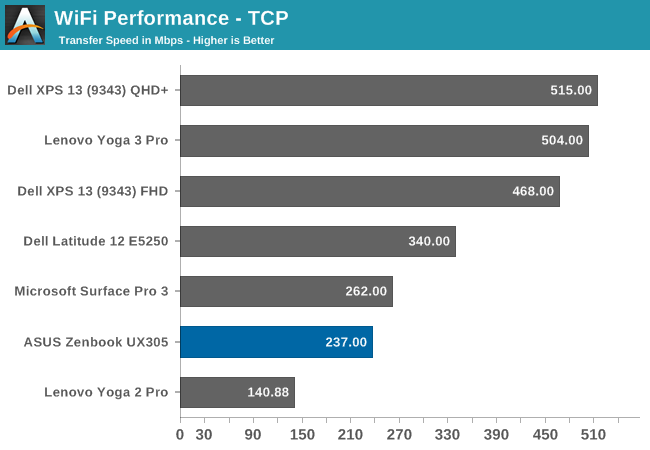
With just 300 Mbps maximum connection speed, the UX305 is sorely outclassed by devices which offer 802.11ac. ASUS is good enough to include a USB 3.0 Ethernet adapter though, for those that require more speed. Using the adapter, I was able to achieve 902 Mpbs transfer rates on our Wi-Fi benchmark. Frankly, I do appreciate the offer, but the money spent on the adapter could have just been used to give the UX305 802.11ac across the board, rather than just on the higher priced model. It is trivial for people to purchase a USB 3.0 Ethernet adapter if they need it, and plug it in, but replacing the Wireless card inside one of today’s laptops is a lot more challenging. This, like the display which raises the laptop, is one decision I have to question about the UX305.
Speakers
In their press materials ASUS has made a big deal about the engineering effort put into the speakers in the UX305, which were developed by the Golden Ear team at ASUS. As stated earlier, the UX305 sports two downward firing speakers, housed in 1.7 cubic centimeter chambers. The speaker dimensions are 25 x 9 x 3 mm and include a “high-intensity” coil. They also include some equalizer software to assist the user in setting the equalizer for various modes, such as VoIP calls, or music.
The audio solution is provided by Conexant and is a 2075x variant, so it should have around 2.8 watts of output power split between the two channels.
All of this being said, playing music I was only able to achieve around 76 dB (A weighted) which is about typical for this type of thin and light device. The outlier here is the Dell XPS 13 which manages 86 dB on the same music track. 10 dB means that the Dell is twice as loud.
However maximum volume is only one side of the equation. We will take a look at the frequency response of the speaker design next.
As you can see from the graph, there is little in the way of low end response, which I suppose is not unexpected for such small speakers. There is really not much in the way of audio response at all until after 200 Hz. There is also a big dip right at 1500 Hz. Overall, these are not the greatest speakers, but they should be fine for watching a few videos. Headphones would be needed for anything where you want to hear the full audio range though.


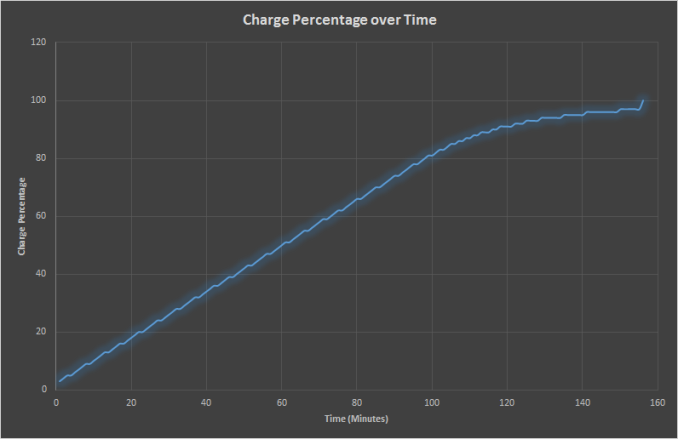
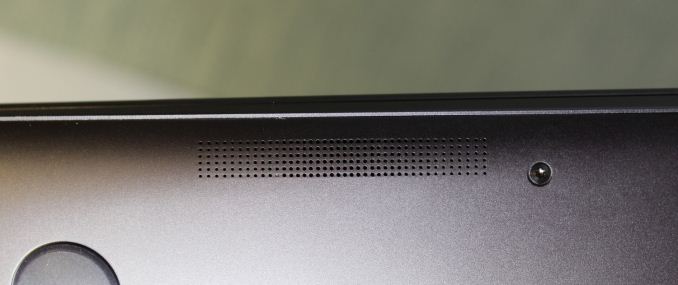
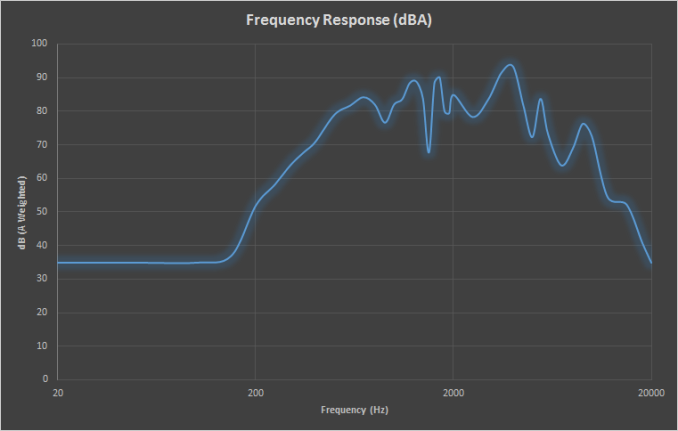








164 Comments
View All Comments
3DoubleD - Wednesday, March 25, 2015 - link
This appears to be a great offering. If they announce pre-calibrated screens (or there was a simple and reliable DIY method) I'd seriously consider buying this device. It seems like ASUS has really been listening: IPS, >= 1080p, decent keyboard, good trackpad, good battery life, good performance, 8 GB RAM, 256 GB SSD, ...more than 1 I/O port, and a great price! On a personal, subjective note, too bad it is so similar to the styling of the Transformer Prime tablet... I'm still angry about how terrible that device performs (eMMC just falls apart with time), which really hurt my opinion of ASUS, it would be best to not be reminded of it.Hulk - Wednesday, March 25, 2015 - link
I assume this unit uses a m.2 drive? What size? 42mm? One slot or two?Gigaplex - Wednesday, March 25, 2015 - link
At this thinness, I'd expect it to be soldered on.Allan_Hundeboll - Wednesday, April 1, 2015 - link
I think its a 80mm m.2 6 gbps sata ssdcasteve - Wednesday, March 25, 2015 - link
The DOTA 2 temperature comparison chart's y-axis is mislabeled as frequency rather than temperature. Also, it looks like the test stopped before the zenbook came to thermal equilibrium. So, will it start to throttle or fry eggs sometime after an hour of heavy use?I'm very happy to see all of the fanless laptops. But, even with a 4.5W TDP CPU, it seems there's still some tuning to be done to get rid of the heat.
djvita - Wednesday, March 25, 2015 - link
Everyone is struggling, Qualcomm, Nvidia and Intel on getting high performance on low power. ARM overheats, and x86 is too slow compared to desktop chips.Brett Howse - Wednesday, March 25, 2015 - link
Sorry I was graphing the clock speeds of the chips and then removed that from the graph and left the temperatures, but forgot to re-label that axis.I'll leave DOTA running for a lot longer and see what happens. Eventually it will need to throttle back a bit.
crimson117 - Wednesday, March 25, 2015 - link
Is there a table somewhere listing the specs for each UX305 model number?Too many skus makes it hard to know what you're getting, eg UX305FA-ASM1, UX305FA-USM1, UX305FA-FB003H, UX305FA-FC008H.
hammer256 - Wednesday, March 25, 2015 - link
That price, that spec. I have a Macbook air (2014) and I am positively jealous.V900 - Wednesday, March 25, 2015 - link
Don't be. The Asus may feel snappy when you browse the web, but as soon as you open a few more programs and try to multitask, the Asus Zenbook will start to protest, and throttle down the speed and/or cores. For anything more than light usage with little or no multitasking your MacBook Air, or any similarly specced computer from 2014/2013 will be faster.